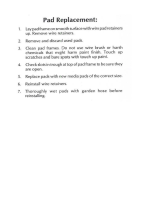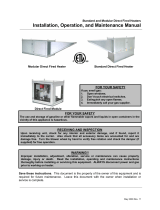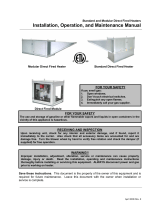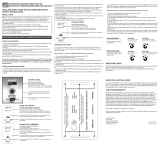
Form O-ADF/RDF, P/N 148385R3, Page 18
3.0 Operation and Service (cont'd)
3.9 Troubleshooting
Chart 1 - System Troubleshooting (Check the diagnostic lights.)
Symptom or Problem Cause and Remedy
1. Disconnect switch is closed, but "control power" light is
not lit.
1. Fuses are missing or blown in disconnect switch - replace fuses.
2. Transformer not wired according to diagram - check wiring.
3. Secondary 8A fuse (on transformer) is missing or blown - replace fuse.
4. Indicator light is burned out - replace bulb (P/N 125189).
2. Disconnect switch is closed, but "restat normal" light is
not lit.
1. See causes and remedies for Problem 1 above.
2. Optional control relay or door switch contacts are open - to test, jump terminals 3 to 4
or 1 to 2
3. Firestat option not ordered - verify order/wiring diagram.
4. Firestat manual reset tripped - reset restat control.
3. Disconnect closed, blower switch in test position, "restat"
light is lit, but "freezestat" light is not lit
1. Freezestat option not ordered - verify order/wiring diagram.
2. Freezestat relay contacts are open - checking setting on control.
3. Indicator bulb is burned out - replace bulb (P/N 125189).
4. Disconnect closed, blower switch in test position, "restat"
and "freezestat" lights are lit, but "starter energized" light is
not lit and the blower motor is not operating.
1. End switch on damper motor not closed. - check end switch wiring.
2. Faulty damper relay - replace relay.
3. Damper motor miswired - rewire damper motor per wiring diagram.
5. Disconnect closed, blower switch in test position,
"restat", "freezestat" and "starter energized" lights are lit,
but the blower motor is not operating.
1. Blower motor not wired correctly - check wiring diagram on motor.
2. Faulty motor starter - replace (check coil rst).
3. Faulty blower motor relay - replace relay.
6. Disconnect closed; blower switch in test position; "restat",
"freezestat" and "starter energized" lights are lit and the
blower motor is operating; but the "low air light" is not lit.
1. Low air switch open - verify pressure drop at burner.
2. Indicator light is burned out - replace bulb (P/N 125189).
3. Faulty low air switch - replace pressure switch (P/N 203932).
7. Disconnect closed; blower switch in test position;
"restat", "freezestat", "starter energized" and "low air" lights
are lit and the blower motor is operating; but the "high air
light" is not lit.
1. High air switch open - verify pressure drop at burner.
2. Indicator light is burned out - replace bulb (P/N 125189).
3. High air switch option not ordered - verify order/wiring diagram.
4. Faulty high air switch - replace pressure switch (P/N 203933).
8. Disconnect closed; blower switch in test position;
"restat", "freezestat", "starter energized", "low air" and "high
air" are lit; but the "limit control normal" light is not lit.
1. Indicator light is burned out - replace bulb (P/N 125189).
2. Tripped manual reset limit control(s) - reset manual control.
3. Faulty manual limit control (s) - replace limit control.
9. Disconnect closed; blower switch in test position;
"restat", "freezestat", "starter energized", "low air", "high
air" and "limit control normal" lights are lit; but the "ambient
(outside air) cutoff normal" light is not lit.
1. Indicator light is burned out - replace bulb (P/N 125189).
2. High ambient control option not ordered - verify order/wiring diagram.
3. High ambient control contacts open - check setting on control.
10. Disconnect closed; blower switch in test position;
"restat", "freezestat", "starter energized", "low air", "high
air", "limit control normal" and "ambient (outside air) cutoff
normal" lights are lit; but the "low gas pressure normal" light
is not lit.
1. Indicator light is burned out - replace bulb (P/N 125189).
2. Low gas pressure switch option not ordered - verify order/wiring diagram.
3. Low gas pressure switch contacts open - check setting on control.
4. Low gas pressure switch contacts open - check gas pressure.
5. Faulty gas pressure switch - replace gas pressure switch.
11. Disconnect closed; blower switch in test position;
"restat", "freezestat", "starter energized", "low air", "high
air", "limit controls normal", "ambient (outside air) cutoff
normal" and "low gas pressure normal" lights are lit; but the
"high gas pressure normal" light is not lit.
1. Indicator light is burned out - replace bulb (P/N 125189).
2. High gas pressure switch option not ordered - verify order/wiring diagram.
3. High gas pressure switch contacts open - check setting on control.
4. High gas pressure switch contacts open - check gas pressure.
5. Manual reset on switch tripped - reset pressure switch manual reset.
6. Faulty gas pressure switch - replace gas pressure switch.
12. Disconnect closed; blower and burner switches in
run position; control switch is in "winter" position; "control
power", "high gas normal"; "low gas normal"; "restat
normal"; "system switch energized"; "starter energized" and
"freezestat normal" lights are lit; but igniter is not becoming
energized or beginning to glow.
1. Lack of power at L1 on ignition module - ECO blown, nd cause then replace ECO.
2. Faulty burner enable relay - replace relay.
3. Low stage relay contacts are not closed - check air controller or thermostat setting.
4. Faulty low stage relay - replace relay.
5. Faulty hot surface ignitor - check continuity at the ignition module and circuit board. If
reading is greater than 5-6 ohms, replace ignitor.
6. Faulty ignition module - replace entire module.
13. Disconnect closed; blower and burner switches in
run position; control switch is in "winter" position; "control
power", high gas normal; "low gas normal"; "restat
normal"; "system switch energized"; "starter energized" and
"freezestat normal" lights are lit; ignitor glowing but "pilot
valve normal" light (thus the pilot valve) is not energized.
1. Ignitor not reaching 1.4A threshold - check voltage and current to ignitor.
2. Faulty hot surface ignitor - check continuity, replace ignitor.
3. Faulty ignition module - replace entire module.
14. Disconnect closed; blower and burner switches in
run position; control switch is in "winter" position; "control
power", high gas normal; "low gas normal"; "restat
normal"; "system switch energized"; "starter energized" and
"freezestat normal" lights are lit; ignitor has reached 1.4A
and has opened the pilot valve bringing on the "pilot valve
normal" light; but the pilot ame is not present. (After two
trials the unit will go into safety lockout requiring cycling of
the main disconnect switch.)
1. Air in pilot gas line - bleed pilot line.
2. Inadequate pilot gas pressure - verify pilot gas pressure (3.5" w.c.)
3. Faulty pilot valve - replace pilot solenoid valve.
4. Faulty ignition module - replace entire module.























